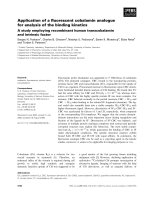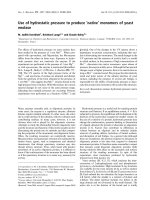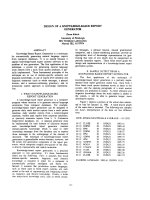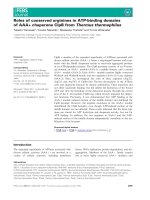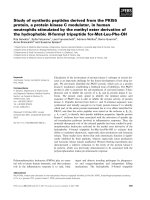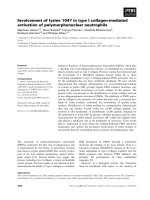Báo cáo khoa học: "USE OF HERRISTIC KNOWLEDGE IN CHINNESE LANGUAGE ANALYSIS" ppt
Bạn đang xem bản rút gọn của tài liệu. Xem và tải ngay bản đầy đủ của tài liệu tại đây (257.97 KB, 4 trang )
USE OF H~ru'RISTIC KN~L~EDGE IN CHINF SELANGUAGEANALYSIS
Yiming Yang, Toyoaki Nishida and Shuji Doshita
Department of Information Science,
Kyoto University,
Sakyo-ku, Kyoto 606, JAPAN
ABSTRACT
This paper describes an analysis method
which uses heuristic knowledge to find local
syntactic structures of Chinese sentences. We
call it a preprocessing, because we use it before
we do global syntactic structure analysisCl]of the
input sentence. Our purpose is to guide the
global analysis through the search space, to
avoid unnecessary computation.
To realize this, we use a set of special
words that appear in commonly used patterns in
Chinese. We call them "characteristic words" .
They enable us to pick out fragments that might
figure in the syntactic structure of the
sentence. Knowledge concerning the use of
characteristic words enables us to rate
alternative fragments, according to pattern
statistics, fragment length, distance between
characteristic words, and so on. The prepro-
cessing system proposes to the global analysis
level a most "likely" partial structure. In case
this choice is rejected, backtracking looks for a
second choice, and so on.
For our system, we use 200 characteristic
words. Their rules are written by 101 automata.
We tested them against 120 sentences taken from
a Chinese physics text book. For this limited
set, correct partial structures were proposed as
first choice for 94% of sentences. Allowing a
2nd choice_, the score is 98%, with a 3rd choice,
the score is 100%.
I. THE PROBLEM OF CHINESE
LANGUAGE ANALYSIS
Being a language in which only characters
( ideograns ) are used, Chinese language has
specific problems. Compared to languages such
as English, there are few formal inflections to
indicate the grammatical category of a word, and
the few inflections that do exist are often
omitted.
In English, postfixes are often used to
distinguish syntactical categories (e.g. transla-
tion, translate; difficul!, dificulty), but in
Chinese it is very common to use the same word
(characters) for a verb, a noun, an adjective,
etc So the ambiguity of syntactic category of
words is a big problem in Chinese analysis.
In another exa~ole, in English, "-ing" is
used to indicate a participle, or "-ed" can be
used to distinguish passive mode from active. In
Chinese, there is nothing to indicate participle,
and although there is aword, "~ " , whose
function is to indicate passive mode, it is often
omitted. Thus for a verb occurring in a sentence,
there is often no w~y of telling if it transitive
or intransitive, active or passive, participle or
predicate of the main sentence, so there may be
many ambiguities in deciding the structure it
occurs in.
If we attempt Chinese language analysis
using a conputer, and try to perform the
syntactic analysis in a straightforward way, we
run into a combinatorial explosion due to such
ambiguities. What is lacking, therefore, is a
simple method to decide syntactic structure.
2. REDUCING AMBIGUITIES USING
CHARACTERISTIC WORDS
In the Chinese language, there is a kind of
word (such as preposition, auxiliary verb,
modifier verb, adverbial noun, etc ), that is
used as an independant word (not an affix). They
usually have key functions, they are not so
numerous, their use is very frequent, and so they
may be used to reduce anbiguities. Here we shall
call them
"characteristic
words".
Several hundreds of these words have been
collected by linguists[2],and they are often used
to distinguish the detailed meaning in each part
of a Chinese sentence. Here we selected about
200 such words, and we use them to try to pick
out fragments of the sentence and figure out
their syntactic structure before we attempt
global syntactic analysis and deep meaning
analysis.
The use of the characteristic words is
described below.
a) Category decision:
Some characteristic words may serve to
decide the category of neighboring words. For
example, words such as "~ ", "~", "~", "4~",
are rather like verb postfixes, indicating that
the preceding word must be a verb, even though
the same characters might spell a noun. Words
like " ~ ", " ~ ", can be used as both verb and
auxiliary. If, for example, "~ " is followed by
a word that could be read as either a verb or a
noun, then this word is a verb and "~ " is an
auxiliary.
b) Fragment picking
In Chinese, many prepositional phrases start
222
I fl,PP
o o
x x
f2, #vP
o 0
x
~
~f5, #VP
o o o
x x
Translation:
©
o
x
The ball must run a longer distance before returning
to the initial altitude on this slope.
distinguish a word fremothers
characteristical word
fragment
verb Or adjective
the word can not he predicate of sentence
Fig.iAn Example of Fragment Finding
with a preposition such as "~", "~", "~", and
finish on a characteristic word belonging to a
subset of adverbial nouns that are often used to
express position, direction, etc When such
characteristic words are spotted in a sentence,
they serve to forecast a prepositional phrase.
Another example is the pattern " { ~", used
a little like " is to " in English, so when
we find it, we may predict a verbal phrase from
"~ " to "%.~", that is in addition the predicate
VP of the sentence.
These forecasts make it more likely for the
subsequent analysis system to find the correct
phrase early.
c) Role deciding
The preceding rules are rather simple rules
like a human might use. With a cxmputer it is
possible to use more ~lex rules (such as
involving many exceptions or providing partial
knowledge) with the same efficiency. For example,
a rule can not usually with certainty decide if a
given verb is the predicate of a sentence, but we
know that a predicate is not likely to precede a
characteristic word such as "~9 " or " { " or
follow a word like "~-~", "~" or "~". We use
this kind of rule to reduce the range of possible
predicates. This knowledge can be used in turn
to predict the partial structure in a sentence,
because the verbal proposition begins with the
predicate and ends at the end of the sentence.
In the example shown in Fig.l, fragments f3
and f4 are obtained through step (a) (see above),
fl through (b), and f2 and f5 through (c). The
symbol "o" shows a possible predicate, and "x"
means that the possibility has been ruled out.
Out of 7 possibilities, only 2 remained.
3. RESOLVING CONFLICT
The rules we mentioned above are written for
each characteristic word independantly. They are
not absolute rules, so when they are applied to a
sentence, several fragments may overlap and thus
be incrmpatible. Several crmabinations of
compatible fragments my exist, and frcm these we
must choose the most "likely" one. Instead of
attempting to evaluate the likelihood of every
combination, we use a scheme that gives different
priority scores to each fragment, and thus
constructs directly the "hest" combination. If
this combination (partial structure) is rejected
by subsequent analysis, back-tracking occurs and
searches for the next possibility, and so on.
Fig.2 shows an example involving conflicting
fragments. We select f3 first because it has the
highest priority. We find that f2 , f4 and f5
collide with f3, so only fl is then selected next.
The resulting combination (fl,f3) is correct.
Fig.3 shows the parsing result obtained by
computer in our preprocessing subsystem.
4. PRIORITY
In the preprocessing, we determine all the
possible fragments that might occur in the
sentence and involving the characteristic words.
Then we give each one a measure of priority. This
measure is a complex function, determined largely
by trial and error. It is calculated by the
following principles:
a) Kind of fragment
Some kinds of fragments, for example, com-
pound verbs involving "~", occur more often than
others and are accordingly given higher priority
223
f2 , PP
t" I
' v/. "F,
~- ,
t. - - - "
r - - ~ f3,V3 I
]
I
Translation
r I
~ J
V/N
: In the perfect situation -without friction the object
will keep moving with constant speed.
: pattern of fragment
: a word which is either a verb or a noun
(undetermined at this stage)
Fig. 2 An Example of Conflicting Fragments
61
III
I
FWD
I
?
I
F M-DO5 DE M-XR1 M FW-D04-FZD0-L6
I I I I I I
2 3 4 5 6 7
I I I I I I
I I I I I I
I I I I I I
AI4A MEI2YOU3 MO2CA1 DE4A LI3XIANG3 QING2KUANG4 XIA4A
S
I
?
I
JD i ~ DODA EN
I ro I
#
I
DO3
I
III
I
DO3 FZDO
I I
14 &
l I
I
15
16
I I I
/UN4DONG4 XIA4A QU4A
Translation
fl , f3
: In the perfect situation without friction the object
will keep moving with constant speed.
: fragment obtained by preprocessing subsystem
: the names of fragments shown in Fig. 2
: the omitted part of the resultant structure tree
Fig. 3 An Exan~le of The Analysing Result Obtained by The Preprocessing Subsystem
224
1 Ii
v3 i vl i
( have processed ) ( finished )I
!
® @
( process ) ( have/finish ) ( -ed )
Translation : had processed
I : fragment given
the higher priority
r ~ : fragment given
: ~ the lower priority
Fi~.4 An Example of Fragment Priority
(Fig.4). We distinguish 26 kinds of fragments.
b)
Preciseness
We call "precise" a pattern that contains
recognizable characteristic words or subpatterns,
and imprecise a pattern that contains words we
cannot recognize at this stage. For example, f3
of Fig.2 is more precise than fl, f2 or f4. We
put the more precise patterns on a higher
priority level.
c) Fragment length
Length is a useful parameter, but its effect
on priority depends on the kind of fragment.
Accordingly, a longer fragment gets higher
priority in some cases, lower priority in other
cases.
The actual rules are rather complex to state
explicitly. At present we use 7 levels of
priority.
tried the method on a set of mere complex
sentences. From the same textbook, out of 800
sentences containing prepositional phrases, 80
contained conflicts, involving 209 phrases. Of
these conflicts, in our test 83% ware resolved at
first choice, 90% at second choice, 98% at third
choice.
6. SUMMARY
In this paper, we outlined a preprocessing
technique for Chinese language analysis.
Heuristic knowledge rules involving a
limited set of characteristic words are used to
forecast partial syntactic structure of sentences
before global analysis, thus restricting the path
through the search space in syntactic analysis.
Comparative processing using knowledge about
priority is introduced to resolve fragment
conflict, and so we can obtain the correct
result as early as possible.
In conclusion, we expect this scheme to be
useful for efficient analysis of a language such
as Chinese that contains a lot of syntactic
ambiguities.
ACKNOWLEDGMENTS
We wish to thank the members of our labora-
tory for their help and fruitful discussions,
and Dr. Alain de Cheveigne for help with the
English.
REFERENCE
[i]. Yiming Yang:
A Study of a System for Analyzing Chinese
Sentence, masters dissertation, (1982)
[2]. Shuxiang Lu:
"~,\~", (800 Mandarin Chinese
Words), Bejing, (1980)
5. PREPROCESSING EFFICIENCY
The preprocessing system for chinese
language mentioned in the paper is in the course
of development and it is partly ~u~leted. The
inputs are sentences separated into words (not
consecutive sequences of characters). We use 200
characteristic words and have written the rules
by I01 automata for ~ them. As a preliminary
evaluation, we tested the system (partly by hand)
against 120 sentences taken from a Chinese
physics text book. Frem these 369 fragments were
obtained, of which 122 ware in conflict. The
result of preprocessing was correct at first
choice ( no back-tracking ) in 94% of sentences.
Allowing one back-tracking yeilded 98%, two back-
trackings gave 100% correctness.
In this limited set, few conflicting pre-
positional phrases appeared. To test the
performance of our preprocessing in this case we
225



